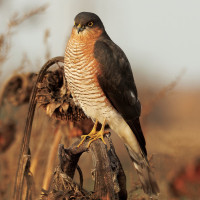Beschreibung
Burrator Reservoir sits among an area of conifer plantations and some deciduous trees almost near the source of the River Meavy, it is probably best known amongst birdwatchers as a night time roost for Gänsesäger, although some other species of duck can be found. Being a quite protected area of water, during bad weather Divers and Grebes and possibly rarer waterfowl species sometimes use this area.
Details
Zugang
On the A386 turn onto the B3212 marked to village of Dousland, at village look for signs to Burrator. The reservoir area can be extremely busy during summer months and even during weekends at other times. When the area is less busy it is possible to drive around the whole reservoir and stop at roadside to view over the water. There are two main car parks, to the south is Burrator Quarry Car Park (nearer to dam) and to the North Norsworthy Bridge Car Park (nearer to conifer plantations and moorland). If staying around the reservoir area the walk is easy, if venturing up to the plantations and moors the walk is more strenuous. The suggested route on the Birdingplaces-map below is 6,7 km.
Terrain und Habitat
Vereinzelte Bäume und Büsche , Wald , Tal , Moor/Heideland , Fluss , SeeBedingungen
Hügelig , Sumpfig , Offene LandschaftRundweg
JaIst ein Spektiv nützlich?
JaGute Beobachtungszeit
GanzjährigBeste Beobachtungszeit
Winter , Sommer , Frühjahrszug , Frühjahr , Herbst , HerbstzugRoute
asphaltierte Straße , Normaler Weg , Schmaler PfadSchwierigkeitsgrad der Tour
DurchschnittlichErreichbarkeit
zu Fuß , Fahrrad , AutoBeobachtungshütten oder -türme
NeinZusätzliche Informationen
Following very hot summers the water level can drop considerably, exposing areas of mud, with a chance of possible waders. As well as the marked route the walker can continue to high moorland further to the North where the elevation rises to over 350 metres plus.


